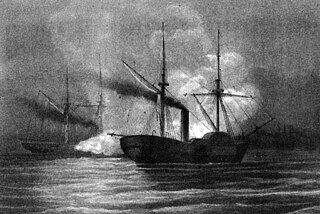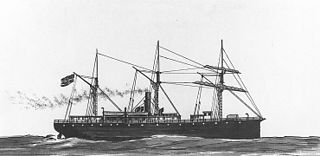
The very first USS Hatteras was a 1,126-ton iron-hulled steamer purchased by the Union Navy at the beginning of the American Civil War. She was outfitted as a gunboat and assigned to the Union blockade of the ports and waterways of the Confederate States of America. During an engagement with the disguised Confederate commerce raider, CSS Alabama, she was taken by surprise and was sunk off the coast of Galveston, Texas. The wreck site is one of the few listed on the National Register of Historic Places because of its location away from destructive surf and because of the ship's side-wheel design, which marks the transition between wooden sailing ships and steam-powered ships.
USS New London was a screw steamer of the Union Navy during the American Civil War. She was outfitted with a Parrott rifle and 32-pounders, and was assigned as a gunboat in the Union blockade of the Confederate States of America.

USS Hendrick Hudson was a schooner-rigged screw steamer.

The third USS Montgomery was a wooden screw steamer in the Union Navy during the American Civil War.

USS South Carolina was a steamer used by the Union Navy during the American Civil War.

The first USS Mount Vernon was a wooden-screw steamer in the United States Navy.

USS Huron was a Unadilla-class gunboat built for the United States Navy during the American Civil War for blockage duty against the ports and rivers of the Confederate States of America.

USS Bienville was a 1,558 long tons (1,583 t) (burden) wooden side-wheel paddle steamer acquired by the Union Navy early in the American Civil War. She was armed with heavy guns and assigned to the Union blockade of the waterways of the Confederate States of America.

USS Morning Light was a sailing ship acquired by the Union Navy during the American Civil War. She was used by the Navy to patrol navigable waterways of the Confederacy to prevent the South from trading with other countries.
USS Fox was a captured Confederate schooner acquired by the Union Navy from the prize court during the American Civil War.
USS Two Sisters was a small 54-ton captured Confederate schooner acquired by the Union Navy from the prize court during the American Civil War.
USS Ariel was a captured Confederate schooner acquired by the Union Navy from the prize court during the American Civil War. She was put into service by the Union Navy to patrol navigable waterways of the Confederacy to prevent the South from trading with other countries.
USS Gem of the Sea was a bark acquired by the Union Navy during the American Civil War. She was used by the Navy to patrol navigable waterways of the Confederacy to prevent the South from trading with other countries.

USS Huntsville was a steamer acquired by the Union Navy during the American Civil War. She was used by the Navy to patrol navigable waterways of the Confederacy to prevent the South from trading with other countries.
USS Massachusetts was a large steamer acquired by the U.S. Navy prior to the American Civil War.
USS Arthur was a bark acquired by the Union Navy during the American Civil War. She was used by the Union Navy as a gunboat in support of the Union Navy blockade of Confederate waterways.
USS Annie was a schooner captured by the Union Navy during the American Civil War. She was used by the Union Navy as a ship's tender in support of the Union Navy blockade of Confederate waterways. Her service during the Union naval blockade of Confederate waters peaked during the Second Chesapeake Affair (1863–64) as a "fresh reinforcement from the south" in the search and capture of the U.S.S Chesapeake.

The first USS Wanderer was a high-speed schooner originally built for pleasure. It was used in 1858 to illegally import slaves from Africa. It was seized for service with the United States Navy during the American Civil War. In U.S. Navy service from 1861 to 1865, and under outright U.S. Navy ownership from 1863 to 1865, she was used by the Union Navy as a gunboat, as a tender, and as a hospital ship. She was decommissioned, put into merchant use, and lost off Cuba in 1871.
The third USS Virginia was a 581-ton blockade-running steamer captured by the United States Navy and put to use during the American Civil War. Virginia served the U.S. Navy primarily as a mortar gunboat. Her ordnance included six 24-pounder howitzers and a 12-pounder rifled gun.

John Cummings Howell was an officer in the United States Navy during the American Civil War. He rose to the rank of rear admiral and late in his career was commander-in-chief of the North Atlantic Squadron and then of the European Squadron.










